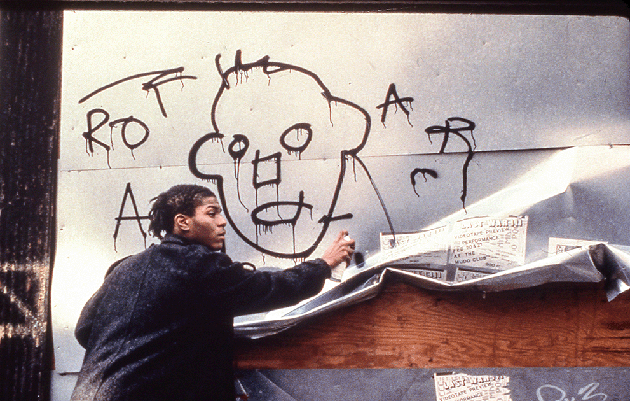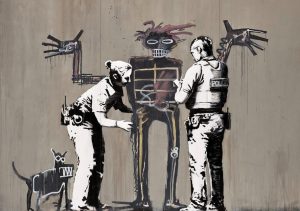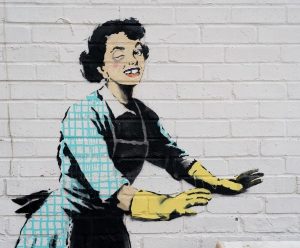Go Flock Yourself, 2008
Spray-paint and emulsion on metal
91.4 x 91.4 cm (36×36 inches)
Signed, inscribed and dated ‘Banksy London 2008’ (on the reverse)
Phillips London: 3 March 2022
Estimated GBP 1,000,000 – 1,500,000
Exhibited
Banksy vs. Bristol Museum, Bristol, 2009
Rising out of the Bristol underground graffiti scene as the most controversial, idiosyncratic talent of the 1990s, the anonymous street artist, painter and social activist Banksy has shocked the art world with his anti-establishment works providing dark humor, satire and political commentary at once. Impacting cities around the world with his political statements and disruptive vision, Banksy’s work initially started appearing on streets, buildings, trains and public spaces. First unveiled in the ground-breaking Banksy vs. Bristol Museum exhibition in the summer of 2009, which brought the artist to international fame, Go Flock Yourself is a unique painting on metal containing some of the conceptual paradoxes the artist has become most known for.

“This is the first show I’ve ever done where taxpayers’ money is being used to hang my pictures up rather than scrape them off.”

Characterized by spray paint and cardboard stencils, Go Flock Yourself portrays a young man caught up in the act of vandalizing a wall in a pink fleur-de-lis pattern – a distinct motif in Banksy’s oeuvre. A tongue in cheek on a well-known phrase and sentiment, the artist ironically transforms the forceful expression of dismissal in the title. With a revolutionary spirit, Banksy’s figure is defiantly looking at someone, most probably the police, showing no intention of stopping his work. Like Banksy, the figure in Go Flock Yourself, uses spray paint to complete his illegal work under the cover of darkness, achieving a meticulous level of detail. Allowing Banksy to create complex images with speed, his distinctive use of stenciling kept him safely beyond the reach of the police. Perhaps this time not as rapid, the element of surprise and the air of challenge, Go Flock Yourself exposes Banksy’s complex and often witty relationship with the police. Using satire to address the representation of bold disobedience, the present work comments on graffiti art as the most immediate and widespread expression of rebellion.

Hyacinthe Francois Rigaud, Portrait of Louis XIV, 1701
Musee du Louvre. Image: Bridgeman Images
Musee du Louvre. Image: Bridgeman Images
Sitting in stark contrast to the remainder of the composition, the pink floral patterned damask pierces through the greyscale painting’s ground. Challenging all ideas in his compositions, this motif echoes the flock wallpapers that tended to adorn high society walls of the 17th century. With a varied meaning and rather obscure origin, the fleur-de-lis first appeared in art history to represent French Royalty, most famously in the renowned Portrait of Louis XIV, 1701, where Hyacinthe François Rigaud adorned the monarch’s voluminous mantle to celebrate his wealth, power and glory. Extracted from its original context, Banksy adopts the fleur-de-lis symbol to embody notions of rioting but also government control, oppression and poverty. A motif in Banksy’s iconography that he has subsequently returned to over the years, the floral pattern significantly first appeared in Banksy’s debut exhibition in the United States, where the artist notably painted a myriad of gold fleur-de-lis on an elephant to address the way poverty was ignored in our society. Additionally in most recent years, Banksy revisited the wallpaper stencil on a mural next to a refugee shelter in Paris to address anti-immigrant policies and today’s escalating concern of young migrants living on the streets.

Still from Downtown 81. Image: MARKA / Alamy Stock Photo
A proud and determined opposition against authority, the present work is reminiscent of the beginning of Jean-Michel Basquiat’s successful career, who famously inscribed provocative phrases and his alter ego tag SAMO© across the New York cityscape of the 1970s. Emerging from similar scenes, both artists encouraged revolution in the art world and moved their work beyond the streets and into international galleries and museums, breaking down the boundaries between vandalism and art. Continuing his predecessor’s legacy, Go Flock Yourself presents a precise image with a singular interpretation subverting an emblem of historical significance to boldly assert disobedience towards law enforcement. With the figure’s expression of defiance and the play on words in the title, that capture on their own the audience attention, Go Flock Yourself is an exceptional and quintessential example of Banksy’s work. It is a unique opportunity to acquire such an incredible work by the global myth who Banksy is.




